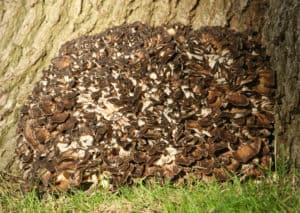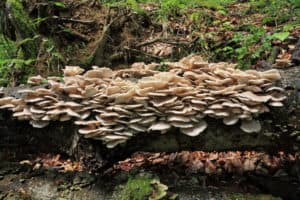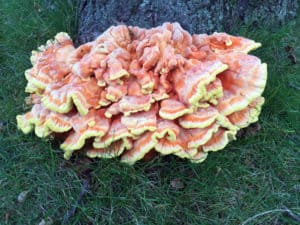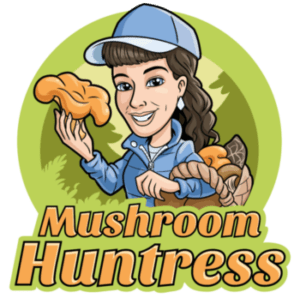Mushroom Cluster Info – What Kind of Mushroom Grows in Clusters?
Throughout history, there’s no doubt that people across the globe have foraged mushrooms for food. Gathering mushrooms in clusters can also be an interesting and fulfilling hobby.
Nonetheless, it’s important to know the mushroom cluster species that are safe for consumption, mouth-watering, and packed with nutrients.
After all, the last thing you need is to consume wild mushrooms that can be detrimental to your health and fatal if ingested in large quantities. Read on as we delve into everything you need to know.

1. Hen of the Woods
Also known as Maitake, Hen of the Woods is an edible mushroom cluster and a favorite for foragers. It lacks dangerous look-alikes making it a safe bet for novices.
Growth
As a polypore, Maitake has tiny pores covering its underside. They grow on tree bases in shelf-like clusters, favoring oak and other hardwoods. These mushroom clusters closely resemble the tail feathers of a sitting hen which explains the name.
An array of Maitake may grow on one tree. While Hen of the Woods is native to China, it grows in the northeastern region of the US and Japan. As a perennial mushroom cluster, it typically grows in the same spot every year.
Identification
Maitake is grey-brown, with the underside of the caps and branch-like stalks being white. The best time to hunt for them is in the fall, as they are harder to find during summer. These mushrooms can grow to become big, with some hunters scoring massive ones weighing up to 23kg (50lbs).
Nevertheless, they usually weigh anywhere between 3lbs and 15lbs (1.5kg to 7kg). Unlike other species, Hen of the Woods lacks gills. Avoid hunting and eating older Maitake that is reddish or orange as they might be contaminated with mold and bacteria.
Nutrition
Hen of the Woods is loaded with nutrients such as vitamin B3 (niacin), B2 (riboflavin), and folate, all of which enhance cellular growth and energy metabolism. The species also contain powerful compounds such as glucans that promote a clean bill of health. Glucans have immune-boosting properties. When infused in sautéed foods, soups, and grain dishes, Maitake has a bold, savory flavor.

2. Oyster Mushroom
Commonly sought after by foragers, the oyster mushroom is a delicious edible species and is prevalent during fall and spring.
Growth
With a close resemblance to an oyster, this mushroom cluster grows in forests across the globe, including North America. You’ll typically find the oyster mushroom on oak trees, dying hardwood trees, dead stumps, or fallen branches.
Oyster mushrooms decompose decaying wood and infuse a wealth of nutrients into the soil. These are then used by other organisms and plants in forest ecosystems.
Identification
The oyster mushroom cluster resembles shelves on dying or dead hardwood trees. Depending on the season of the year, the caps of these mushrooms range from brown and white to grey.
Furthermore, the undersides of the caps are layered with close-knit gills that run from the stubby stem and are tan or white.
Oyster mushrooms are usually anywhere between 2 inches and 8 inches in height, with a width of 5cm to 20cm. Additionally, you’ll find a wealth of clusters on the same tree every year.
Nutrition
Oyster mushrooms have white, thick, subtle-tasting flesh that’s loaded with nutrients such as riboflavin (vitamin B2), niacin (vitamin B3), and minerals such as zinc, copper, iron, and potassium. Furthermore, they contain lectins and glycoproteins that protect you from chronic ailments.
Oyster mushrooms are perfect when sautéed with garlic and onions as a side dish. Alternatively, they are a great addition to meat dishes, as a meat substitute, various kinds of pasta, and soups.

3. The Sulfur Shelf
Also known as Chicken of the Woods, the Sulfur Shelf mushroom cluster is a vibrant yellow or range species with a distinct, meaty flavor.
Growth
You’ll typically find Sulfur Shelf mushrooms growing on hardwood trees in Europe and the US, particularly east of the Rocky Mountains. The species can serve as parasites on dying or living hardwood trees or extract nutrients from rotting tree stumps.
Sulfur Shelf mushrooms grow in dense clusters and are prevalent during the fall and summer on large oak trees. It’s worth noting that the mushroom cluster has a look-alike known as Laetiporus that thrives on conifer trees and should be avoided as they may trigger allergic reactions in some people.
Identification
Sulfur Shelf mushrooms are usually yellow or orange and grow in overlapping shelf-like clusters on chestnut, oak, and willow trees. The caps of the species are semicircular or fan-like, measuring 5cm to 30cm in width and up to 20cm (8 inches) in height.
Additionally, unlike other mushroom species, Sulfur Shelf lacks gills, and the underside of the caps is peppered with small pores. They also have a smooth, suede texture that turns white when the mushrooms have fully matured.
A boatload of these mushrooms may grow on a tree every year, with each growing to be heavier than 23kg (50lbs).
Nutrition
Like most mushroom species, Sulfur Shelf are low in calories and are loaded with nutrients ranging from magnesium, fiber, potassium, phosphorus, and vitamin C to zinc. Furthermore, the mushroom cluster contains plant compounds such as cinnamic acid and polysaccharides that possess tumor-preventing, antioxidant, and antifungal properties.
Rather than eating them raw, Sulfur Shelf mushrooms should be cooked to tap into their hearty flavor coupled with meaty texture by sautéing them with butter, adding them to your omelet or veggie cuisines.
The Bottom Line
Sulfur Shelf, Oyster, and Hen of the Woods mushrooms are highly nutritious, safe, and flavorful wild mushroom species prized by foragers. While foraging for wild mushroom varieties can be a thrilling and fulfilling pastime activity, novice hunters should team up with connoisseurs with experience in mushroom identification. They’ll learn the ropes of how to properly identify and handle mushrooms.
Furthermore, during the hunting escapades, always have a guide that contains info on the edible mushroom types that grow in your jurisdiction. That’ll help you identify safe edible mushroom varieties. Remember, mushroom identification is important.
Lastly, don’t pick an edible mushroom past its prime, which means signs of decaying flesh, a putrid smell, or insect infestation.




